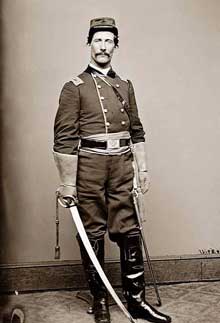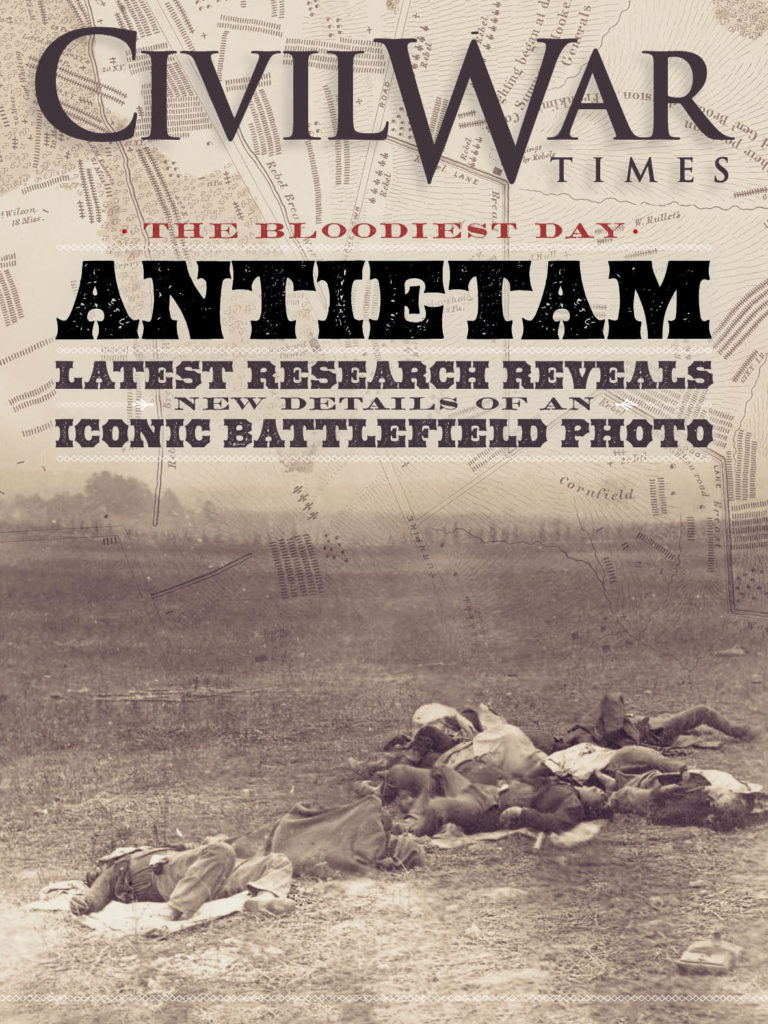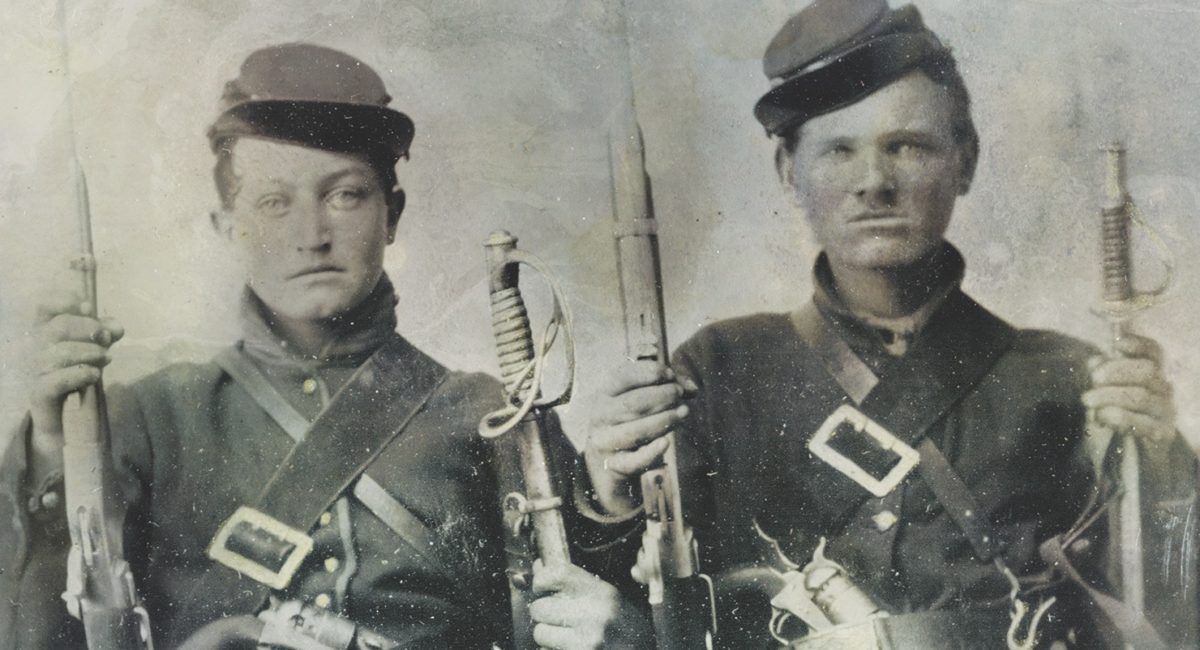
How Many Fought?
About 2.75 million soldiers fought in the Civil War—2 million for the North and 750,000 for the South.
The Average Soldier
According to historian Bell I. Wiley, who pioneered the study of the Civil War common soldier, the average Yank or Reb was a ‘white, native-born, farmer, protestant, single, between 18 and 29.’ He stood about 5 feet 8 inches tall and weighed about 143 pounds. Most soldiers were between the ages of 18 and 39 with an average age just under 26.
Making a Living
The majority of soldiers North and South had been farmers before the war. Union rosters contained references to more than 300 different careers, including accountant, surveyor, locksmith, teacher, carpenter, shoemaker, blacksmith, painter, mason, teamster, and mechanic. Southerners who had not farmed included carpenters, mechanics, merchants, machinists, lawyers, teachers, blacksmiths, and dentists.
Rifle, Carbine, or Cannon?
In the Union army, 80 percent of the men were in the infantry, 14 percent in the cavalry, and 6 percent in artillery. In the Confederate army, 75 percent of the men served in the infantry, 20 percent in the cavalry, and 5 percent in artillery.
UNION SOLDIERS
- Total numbers of the Union armies are estimated to be between 1.5 million and 2.4 million. The bulk of these men were volunteers, though estimates say that 5 to 6 percent were conscripts.
- Read more about Union Soldiers.
The Odds Against Them
Of every 1,000 Federals, 112 were wounded; 150 of every 1,000 Confederates were hit. A Yankee stood a 1 in 8 chance of dying due to illness and a 1 in 18 chance of dying in battle. A Rebel faced a 1 in 5 chance of succumbing to disease and a 1 in 8 chance of dying in combat.
How many soldiers died in the civil war?
Over 360,000 died in service to the North, 110,000+ in battle and 250,000+ of other causes, primarily disease. The South lost over 260,000 men, 95,000+ in battle and 165,000+ to other causes, primarily disease. Some recent estimates claim the totals were actually higher.
Prisoners of War
Roughly 211,000 Union soldiers were captured; 17,000 were paroled in the field; 30,000, or about 15.5% of those sent to prisoner of war camps, died there. Over 426,000 Confederates were captured, of which some 248,000 were paroled in the field; imprisoned in the North, and 26,000, or 12% of those sent to POW camps, died in captivity.
Why They Fought
Men on both sides were inspired to fight by patriotism, state pride, the chance for adventure, steady pay. Union soldiers fought to preserve the Union; the common Confederate fought to defend his home. Later in the war, increasing numbers of Federal soldiers fought to abolish slavery, if for no other reason than to end the war quickly. Confederate soldiers sometimes fought because they feared Union victory would result in a society where black people were placed on an even footing with whites.
Army Melting Pots
The large majority of Civil War soldiers were native born. Nonetheless, large numbers of stout-hearted newcomers to the country also volunteered to fight—especially in the North. Nearly one quarter of the Union’s soldiers were immigrants, including 200,000 Germans; 150,000 Irish; 45,000 English; 15,000 Canadians, and lesser numbers of French, Norwegians, Italians, Mexicans, and Poles. Exact figures for the South are sketchy, but tens of thousands of Irish, Germans, British, French, Canadians, Dutch, and Austrians entered Confederate ranks.
Black Troops
By war’s end, African-American soldiers made up roughly 10 percent of the Union army. Approximately 179,000 black soldiers wore the blue; 37,000 lost their lives. In March 1865, the Confederate congress authorized the army to recruit 300,000 black troops. Some units were raised, but it was too late for them to make a difference.
Soothing the Savage Breast
Johnny Reb and Billy Yank loved to sing—on the march, in camp, and sometimes even in battle. The men in blue favored ‘Battle Cry of Freedom,’ ‘Red White and Blue,’ ‘The Star Spangled Banner,’ and others. The men in gray cherished ‘Dixie,’ ‘Bonnie Blue Flag,’ ‘Yellow Rose of Texas,’ and other songs. Both sides were moved by the heartbreaking tune ‘Home Sweet Home.’
Mess Time
‘What breakfast could possibly compare with this,’ Union Lieutenant Theodore Ayrault Dodge wrote in his journal in 1862—’hard crackers, boiled beef (2 days in the haversack) and bologna sausage (ditto).’ Officially, the daily Union ration consisted of 22 ounces of bread and either 12 ounces of pork or a pound of salted beef. Confederates were supposed to be supplied (but seldom were) with 12 ounces of bacon or 20 ounces of beef (usually salted) along with 18 ounces of flour or 20 ounces of corn meal or hard bread. Vegetables such as beans and peas often proved hard to come by, especially for the Rebs. Usually, Yankees banked on hardtack and coffee, while their counterparts tried to get by on corn bread and coffee. Men on both sides got what they could from sutlers or foraging. Coffee and tobacco were common cravings.
The Wages of War
Soldiers on each side initially earned $11 per month. In June 1864, the Confederacy raised each soldier’s pay to $18 per month, a sum worth less and less as the Confederate dollar dropped in value. That same month the Union upgraded its soldiers’ monthly wage to $16. Black soldiers were initially paid just $10 per month—minus the $3 clothing allowance that white troops received. After June 1864, black soldiers who had been free men before the war were paid the same as whites, but recently freed slaves who joined the army’s ranks did not get the raise.
CONFEDERATE SOLDIERS
- Estimates of the total number of confederate soldiers is difficult, and range between 750,000 to 1 million soldiers fought during the Civil War.
- Learn more about Confederate Soldiers.
Passing the Time
Soldiers had to deal with much boredom. To fill the hours, Yanks and Rebels wrote letter after letter to family, friends, and sweethearts. In spite of the warnings of officers, bouts of drinking and especially gambling broke out. Soldiers played checkers, chess, and baseball, whittled and carved, and if they were feeling particularly creative, would even put on plays. Tennessean Sam Watkins described one winter diversion: ‘Brigades and divisions were soon involved, and such a scene was never before seen on earth. Many thousands of men were engaged in a snow ball battle.’ Both sides read whatever they could get their hands on: Yankees favored Frank Leslie’s Illustrated Newspaper, Harper’s Weekly, American Review, and The Atlantic. Confederates read Southern Illustrated News, Southern Literary Messenger, and Field and Fireside. Both sides loved dime novels and the Bible.
Dirt and Disease
Whenever armies remained settled in camp, sanitary conditions worsened. For starters, until later in the war, latrines were often built upwind or even upstream from camps. Accumulation over time created an unpleasant and unhealthy environment. Eventually, refuse from cooking and slaughtered animals began to cover the ground, and the local water source often became fouled. Disease spread rapidly.
Religion
Both armies claimed to be fighting with God’s blessing, and religion played a big part in the lives of many soldiers. ‘Sometimes, a few of the fellows would gather in prayer, while the rest of us fought the guns,’ wrote Confederate soldier William M. Dame. ‘Several times…we met under fire…we held that prayer hour every day, at sunset, during the entire campaign.’ While the slaughter and grief of war drove some men from their faith, religious revivals swept through both armies, claiming thousands of converts. Most of the men were Christian, though 7,000 Jews fought for the Union and 3,000 for the South. 600 Jewish soldiers died in the war.

this article first appeared in the December 2003 issue of civil war times
Some data has been edited due to new research since the original article was published.

